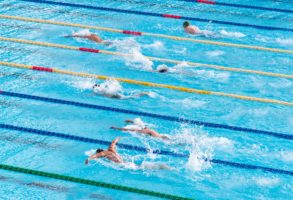
Published May 25, 2021
Michigan Senate
On May 25, 2021, EPPC Kate O’Beirne Fellow Mary Rice Hasson presented the following testimony to the Michigan State Senate Committee on Education and Career Readiness on SB 218, which provides for single-sex high school athletics, determined on the basis of biological sex.
Thank you, members of the Committee, for this opportunity to testify in support of Senate Bill 218.
I’m an attorney and public policy expert at the Ethics and Public Policy Center in Washington DC., where I have been researching, writing, and consulting on issues related to women, education, and public policy for over a decade. In March of this year, I testified on the Equality Act in the United States Senate committee hearings.
I support Senate Bill 218, which provides for single-sex high school athletics, determined on the basis of biological sex, because this legislation is vital to ensuring continued fairness and equal opportunity in high school athletics, for both males and females.
It has been nearly 50 years since Title IX became law and ensured equal educational opportunities on the basis of sex. Title IX was pivotal for females: athletic opportunities for girls and young women, particularly at the high school level, skyrocketed in the years following its enactment. On a national level, ten times as many females now participate in high school sports compared to the pre- Title IX era.[1] What changed? Because of Title IX, schools created new opportunities for girls and young women—females—to participate and compete in athletic activities with other females. Because of these new opportunities, females—in massive numbers—came off the sidelines and became athletes, experiencing the exhilaration of competition, teamwork, fitness, recognition, and athletic excellence. Because of the opportunity to compete in high school, millions of female athletes have had the chance to go to college, their educations funded by the athletic scholarships they earned.
According to a 2020 report by the Institute for the Study of Youth Sports,[2] nearly half (48%) of high school females in Michigan are athletes, higher than the national average (42%). According to CBS sports, Michigan boasted two of the nation’s top 25 female athletes in the class of 2020 – Jess Mruzik, Gatorade’s National Player of the Year in Volleyball, and Zofia Dudek, a cross-country champion and national standout.[3]
This outstanding level of participation and achievement for female athletes is possible only because of female sports teams – teams separated on the basis of biological sex. How do we know? Because pre-Title IX, females did not participate at the same level, achieve the same levels of excellence, nor enjoy the same level of opportunities. The reason why we have female sports is because we recognize the significant physiological and anatomical differences between males and females, and the resulting performance advantage for males—an advantage that has not diminished even though female athletes now receive the same top-level training as male athletes.
SB 218 stands in this tradition of ensuring fairness in high school sports by ensuring that athletes who are competing on teams for “boys’” or “girls” are competing against persons of the same biological sex.
SB 218 is timely and well-drafted legislation, appropriately tailored and inclusive in intent, and well-supported by evidence. By specifying biological sex as the basis for separate athletic activities, SB 218 ensures fairness between males and females in high school athletics. Specifically:
- SB 218 is evidence-based in specifying biological sex as the basis for separate athletic activities: A research review published this year in the journal Sports Medicine states that “the performance gap between males and females becomes significant at puberty and often amounts to 10-50%, depending on the sport.”[4] This performance gap is greatest in sports like track and field that require explosive power – track and field, incidentally, is the most popular sport in Michigan for high school female athletes, drawing 488,000 participants annually.[5]
The basis of this performance gap is physiological: Males and females are physiologically different–on average, males have a built-in biological advantage. They are bigger, stronger, faster, have more muscle mass, stronger bones, greater lung and cardio capacity, and more fast-twitch muscle fibers (which gives an advantage in explosive power); males, on average, also have more upper-body muscle and lower-body muscle than females.[6] The male body is simply built differently—an advantage conferred by nature. As exercise physiologists have long acknowledged, in direct competitions between male and female athletes, males will win. For females to have the chance to win, especially at elite levels of competition, males and females must compete in separate categories.[7]
This performance advantage cannot be erased even when males suppress their testosterone production: longitudinal studies show that “the loss of lean body mass, muscle area and strength typically amounts to 5% after 12 months of treatment” to suppress testosterone.[8] Moreover, suppressing testosterone does not eliminate enduring male-bodied anatomical advantages. A 15-year-old male who uses medication to suppress his natural testosterone does not lose the performance advantages conferred by nature, rooted in numerous physiological differences.
- SB 218 applies only to high school athletics and thus is narrowly drawn and appropriately tailored to the period when physiological differences between males and females (magnified by the effects of puberty) become most significant to athletic performance.
- SB 218 is inclusive, covering all students, and applying equally to males and females. All males and females have a place to play. Because every person has a sex (this is the nature of being human) and the bill designates biological sex as the basis for separate athletic activities, no one is excluded from participation.
A team organized on the basis of sex (male or female) might include students who “identify” in diverse ways. Participation or membership on the team is not restricted on the basis of gender identity. Students of any gender identity can compete according to biological sex. It is completely false to characterize this bill, as some critics have done, as excluding or “banning” students who identity as transgender.[9] Students who identify as transgender are welcome to participate in high school athletics on the same basis as every other student—on the basis of biological sex.
Further, nothing in SB 218 precludes schools from offering coed sports. The bill’s mandate for biological sex as the categorical basis for high school athletics applies only to teams that are labeled for males (or boys or men) or females (or girls or women). Currently, the average Michigan high school offers nine athletic teams for females.[10] Without this bill, the number of female athletic teams per school potentially drops to zero because, absent a biological sex requirement, these athletic teams effectively become coed teams, eliminating opportunities for females to participate equally and to excel in fair competitions.
- SB 218 ensures fairness at every skill level because it applies to students who “compet[e] for a position” or who are “selected to compete” on a single-sex team (based on biological sex). Fairness in high school athletics is important not only for the top athlete competing for a championship but also for the lesser-skilled athlete simply competing to earn the last spot on the team. While the lost opportunities of elite female athletes make headlines–for example in Connecticut, where male-bodied high school athletes took home 15 state championship titles in girls’ track competitions–the lost opportunities of ordinary female athletes, whose spots on the team are taken by mediocre male-bodied athletes, is no less unfair.
- The bill ensures consistency in high school athletics across the state by requiring biological sexual difference to be the basis for establishing single-sex athletic activities, regardless of how those activities are currently labeled (whether using sex-based terms such as “male” or “female” or gendered terms such as “girls,” “women’s,” “boys,” or “men’s”). This language ensures consistency in schools across the state, in spite of local differences in how single-sex teams are labeled.
Finally, I want to address those critics who say SB 218 is “unnecessary” because it has been reported that only two students identifying as transgender apply to compete with the opposite sex each year, on average. How many lost spots on the team or lost championship opportunities for females are “enough” to make this bill necessary? Why should even one female be deprived of the opportunities that come from competing in female-only competitions? Female track athletes in Connecticut learned that hard way just how many opportunities for females can be lost when two—only two– biological males compete in “girls’” athletics: 15 championships, plus numerous unquantifiable related opportunities. (Over several years, two biological males who identify as transgender girls competed in Connecticut girls’ track competitions, taking 15 championship titles away from female athletes, and displacing numerous others from even competing at the state level.)[11] To focus on how many cases have occurred thus far, or the small number of male athletes currently seeking to participate as “girls” privileges the desires of male-bodied athletes over the rights of female athletes. How many high school females have to lose out, whether in making the team or standing on the championship podium, before this law would be “necessary”?
Simply put, fairness in sports at the high school level requires separation on the basis of biological sex. For these reasons, I support Senate Bill 218.
[1] Kennedy, C. L. (2010). A new frontier for women’s sports (beyond title IX). Gender Issues, (1-2), 78. doi:10.1007/s12147-010-9091-y
[2] Kochanek, Jill and Gould, Daniel, The Status of High School Girls’ Sport Participation: A Report Compiled for the State of Michigan Women in Sports Task Force, Institute for the Study of Youth Sports, Michigan State University, East Lansing, Michigan (2020)
[3] “MaxPreps Must Know: 25 Female High School Athletes from the Class of 2020,” CBSSports.com, May 6, 2020. https://www.maxpreps.com/news/KmJo-xHcD0KO4lW-LXAt-A/maxpreps-must-know–25-female-high-school-athletes-from-the-class-of-2020.htm
[4] Hilton, E. and Lundberg, T, Transgender Women in the Female Category of Sport: Perspectives on Testosterone Suppression and Performance Advantage, Sports Medicine (2021) 51:199-214. https://doi.org/10.1007/s40279-020-01389-3
[5] Kochanek, Jill and Gould, Daniel, The Status of High School Girls’ Sport Participation: A Report Compiled for the State of Michigan Women in Sports Task Force, Institute for the Study of Youth Sports, Michigan State University, East Lansing, Michigan (2020)
[6] Saez-Saez de Villarreal E., Requena B., Newton R. U. (2010). Does plyometric training improve strength performance? A meta-analysis. J. Sci. Med. Sport 13 513–522. 10.1016/j.jsams.2009.08.005. Miller AE, MacDougall JD, Tarnopolsky MA, Sale DG. Gender differences in strength and muscle fiber characteristics. Eur J Appl Physiol Occup Physiol. 1993;66(3):254-62. doi: 10.1007/BF00235103. PMID: 8477683.
[7] “Virtually all elite sports are segregated into male and female competitions. The main justification is to allow women a chance to win, as women have major disadvantages against men who are, on average, taller, stronger, and faster and have greater endurance due to their larger, stronger muscles and bones as well as a higher circulating hemoglobin level. Hence, elite female competition forms a protected category with entry that must be restricted by an objective eligibility criterion related, by necessity, to the relevant sex-specific physical advantages.” Handelsman, D. J., Hirschberg, A. L., & Bermon, S. (2018). Circulating Testosterone as the Hormonal Basis of Sex Differences in Athletic Performance. Endocrine reviews, 39(5), 803–829. https://doi.org/10.1210/er.2018-00020
[8] Hilton, E. and Lundberg, T, Transgender Women in the Female Category of Sport: Perspectives on Testosterone Suppression and Performance Advantage, Sports Medicine (2021) 51:199-214. https://doi.org/10.1007/s40279-020-01389-3
[9] Mary Kuhlman, “Opponents of Michigan’s proposed trans sports ban are working to educate people about its dangers,” Detroit Metro Times, April 9, 2021. https://www.metrotimes.com/news-hits/archives/2021/04/09/opponents-of-michigans-proposed-trans-sports-ban-are-working-to-educate-people-about-its-dangers
[10] Kochanek, Jill and Gould, Daniel, The Status of High School Girls’ Sport Participation: A Report Compiled for the State of Michigan Women in Sports Task Force, Institute for the Study of Youth Sports, Michigan State University, East Lansing, Michigan (2020)
[11] “Taking a Stand to Defend Women’s Sports: The Selina Soule, Chelsea Mitchell, and Alanna Smith Stories,” Alliance Defending Freedom. https://adflegal.org/selina-soule-track-athlete-story












